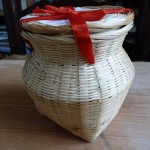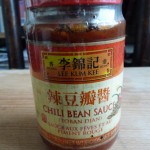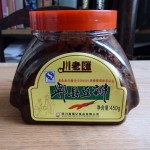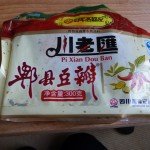Sichuan chilli bean paste
I spent yesterday experimenting in my kitchen with Zhang Xiaozhong, the head chef of Barshu restaurant, where I work as consultant. A few people have emailed me to ask which Chinese seasonings to use, and so while Chef Zhang was here, I asked him to give me his opinion of a few versions of chilli and broad bean paste (豆瓣酱), which is one of the essential flavourings of the Sichuanese kitchen. When I first started writing about Sichuanese food, the only brand available in the West seemed to be Lee Kum Kee’s chilli bean sauce (toban djan), but a few others are now on sale in Chinatown in London. These are the ones we tasted, with some of Chef Zhang’s comments:
Sichuan Dan Dan Seasoning Co Ltd: This was the best of the bunch, with a good colour and taste, and no extraneous ingredients. It simply  contains chillies, broad (fava) beans, salt and wheatflour, as it should. This one is close to those people use in Sichuan, although it’s by no means a top-level product (Serious chefs in Sichuan, however, often commission artisanal products from small workshops, because they don’t trust those produced by factory operations.)
Lee Kum Kee Chili Bean Sauce (toban djan): Chef Zhang points out that this is made by a Cantonese rather than a Sichuanese company, and contains various non-traditional additives, such as sugar, garlic, modified cornstarch, lactic acid and two flavour enhancers. (It’s hard to understand why additives are required in a product that traditionally keeps well and is intensely flavoured…) He didn’t feel this was really suitable for creating an authentic Sichuanese ‘homestyle flavour’ (家常味型), because the colour and the flavour were wrong. (Sichuanese chilli bean pastes, once matured, have a deep, almost-purplish red colour.)
Chuan Lao Hui Pixian Douban (å·è€æ±‡éƒ«åŽ¿è±†ç“£ï¼‰ï¼šHe thought this one was ‘ordinary, OK (一般)’. He preferred the ‘red oil chilli bean sauce’ (红油豆瓣)produced by the same company, although he wasn’t wildly enthusiastic about that either. (The ‘red oil’ version does, however, contain various extra ingredients, including sugar, MSG and spices, while the regular version contains only chillies, broad (fava) beans, salt and wheatflour. Non-Chinese speakers will be able to recognise it because the pot is the same distinctive shape, but the sauce itself is a lighter red, and oily). The regular Pixian paste is also available in plastic packages (picture below).
Hope this is helpful.





101 Responses to “Sichuan chilli bean paste”
Been looking for this today but nowhere on Chinatown sells the DanDan seasoning; blank looks all round when asking for it, even showing the picture didn’t help. Could you name a shop that sells it? Thanks! ðŸœ
Also… why do I have to scroll down to the bottom the page to post a reply? ðŸ˜